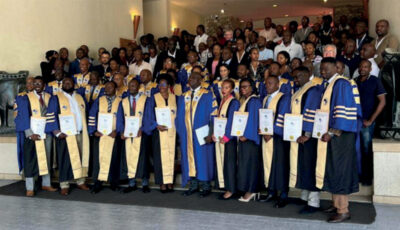Main content
Every year an estimated 234 million surgeries are performed worldwide of which only 3.5% of the total volume is done on the poorest one third of the world’s population. [1] In 2008 in the governmental sector in Sierra Leone, there were only 21 special-ists, five medical doctors (MD) and fourteen non-physician clinicians (NPCs). Three quarters of the health workers that perform surgery in the governmental institutions were located in the capital Freetown.[2] In a recent household survey about 25% of the respondents reported a surgical condition that needed attention and 25% of household members who died in the last year could have benefited from surgery.[3] With the introduc-tion of free health care the demand for surgical inter-vention has increased. [4]
Over the last five years, an average of twenty students have graduated from medical school in Sierra Leone. [5] Currently there are no pos-sibilities to specialize in surgery or obstetrics within the country. Low production of MDs and few training opportunities contribute to vacant positions in surgery and obstetrics especially in the districts. An option to increase the surgical workforce for the district is to introduce the concept of task-shifting.
Task-shifting
Task-shifting is the delegation of certain medical responsibili-ties to less specialized health care workers. Globally the concept gained attention for HIV treatment provided by NPCs, nurses and midwives. [6] Successful examples of task-shifting in Sierra Leone are the cataract operations done by ophthalmic nurses and the anesthetic care given by anesthesia nurses. [7]
Surgical task-shifting is the delegation of certain procedures from consultant specialists to MDs and from MDs to NPCs. The World Health Organization (WHO) recommends task-shifting to (high level) associate clinicians for manual placenta removal, vacuum extraction and cesarean sections if training and supervision are sufficient. [8]
Although the delegation of surgical tasks to non-specialized MDs has been widely implemented in West Africa, there is very little culture for task-shifting in surgery and obstetrics to non-physicians. This is in contrast to the East side of the continent, where it is common practice. Many of the cesarean sections performed in district hospitals in East Africa are performed by non NPCs (Malawi 90%, Tanzania 84% and Mozambique 92%). [9]
A meta-analysis of six controlled studies in East Africa showed no significant difference in the maternal and perinatal out-come for cesarean sections done by clinical officers and MDs. [10]
The WHO has launched the Emergency and Essential Surgical Care (EESC) programme to address the lack of adequate surgi-cal capacity as a global public health issue. Sierra Leone is one of the 35 countries that have adopted the programme. It focuses on implementation of training materials, improving surgical infrastructure and implementing resources for monitoring and evaluating surgical, obstetrical and anesthetic capacity. [11]
The surgical training programme
In cooperation with the Ministry of Health and Sanitation (MoHS) the Norwegian NGO CapaCare has designed a surgical training programme (STP) to train MDs and NPCs in basic life saving surgery and obstetrics. The two-year training is fol-lowed by an oral and written exam and housemanships in the governmental hospitals in Freetown. The training is divided into a practical part and a theoretical part. The first six months of basic training are conducted at the central training centre, Masanga Hospital, before the students are assigned to rotations at two or three partner hospitals. Currently the programme is cooperating with twelve partner hospitals. The partner hospi-tals are selected on the basis of their surgical capacity, coverage of supervision and the availability of surgical resources.
The curriculum for the programme is based on the books Sur-gical Care at the District Hospital, [12] Anesthesia at the District Hospital[13] and the Life Saving Skills Manual. [14] The curricu-lum has been divided into seven different modules taught by different visiting consultant specialists. All procedures where students participate are recorded in a logbook. During the rota-tions the progress of the student is evaluated on a regular basis.
In July 2014, three and a half years after the start of the pro-gramme, 31 students were enrolled. Thirty of the students were trained as NPCs and one as an MD, 26 males and five females.
Out of the 31 students eleven passed the exam, sixteen are in the initial two years of training and five have dropped out of the programme (3 because of performance and 2 on request). From the eleven that passed the final exam, eight are in houseman-ships, two have started working in district hospitals and the medical doctor is in surgical-specialist training in Ghana.
Surgical procedures
All students together have participated in 14,902 surgical procedures in fifteen hospitals all over Sierra Leone, either as observer (20.7%), assistant (40.6%), surgeon under direct supervision (18.4%) or surgeon under indirect supervision (20.3%).
The majority (58.7%) of procedures were planned operations.
Of all procedures 8,756 were soft tissue surgeries, 5,540 ob-stetrics or gynecology, 603 orthopedic procedures and 3 neuro surgeries.
The three most performed procedures were inguinal hernia repair (26.1%); cesarean section (21.1%) and explorative lapa-rotomy (4.5%) see table 1.
| Procedure | Percentage |
|---|---|
| Inguinal hernia repair | 26.1% |
| Cesarean section | 21.1% |
| Explorative laparotomy | 4.5% |
| Appendectomy | 3.3% |
| Scrotal hydrocele | 3.3% |
| Tubal ligation | 3.3% |
| Hysterectomy | 3.0% |
| Dilation and curettage | 2.9% |
| Incision and drainage | 2.9% |
| Obstetrics and gynecology other | 2.7% |
The ultimate goal of surgical task-shifting is to increase capac-ity while maintaining high quality care in circumstances where the availability of human resources is limited. To sustain a high standard of care there should be a regulatory body that ensures proper certification, supervision and continuous learning. [15] At the moment this is lacking in Sierra Leone. The STP will only be successful if the MoHS or any other relevant political body is able to set up a control mechanism that certifies, supervises and regulates the surgical practice of NPCs.
One of CapaCare’s main pillars is research and generation of new knowledge. Therefore a baseline study has been conducted at the beginning of 2013 to measure the surgical activity in the country in all health facilities before the graduation of the first STP students. After five years the same study could be con-ducted to assess if there is an increase in surgeries performed by non-specialists.
Ebola outbreak
Since the first identified Sierra Leonean cases of Ebola in May 2014, the outbreak is ruining the health care of this country, as well as in neighbouring countries. The whole country is focused on fighting this threat and the normal clinical work is more or less put on hold. Patients are trying to avoid hospitals because of fear of infection and isolation. About 10% of the people who have died of Ebola infection have, up to now, been health workers. This has had a large negative impact on an al-ready weak health care system, and also for the STP. Almost all the NGO partners have closed down their hospitals and most elective surgery is postponed.
Based on civil unrest and the fact that personal protective equipment was not sufficiently available we had to stop all the doctor training. One month later, one of our students passed away due to Ebola. Based on the fact that surgical exposure was limited and that there were, in general, limited protective resources, we have chosen to stop clinical rotations in order to avoid putting the students at further risk.
We hope that international intervention will soon lead to im-provement in this situation and that we will be able to continue the training. The damage to the health system will be enor-mous and training of health care workers in basic life saving surgery will be essential for meeting the need of the Sierra Leonean population after the Ebola epidemic.
Conclusion
The Surgical Training Programme has been designed to increase the surgical capacity in Sierra Leone by training MDs and NPCs health officers in basic life saving surgery. This is done by using the concept of task-shifting in surgery widely used in East Africa. In the first 3.5 years eleven students passed the exam and the first two have started employment in district hospitals. The Ebola outbreak has a major negative impact on the Sierra Leonean health care system and the programme. Within the coming four years our aim is for all district hospi-tals in Sierra Leone to have at least two to three of the gradu-ates of this programme available to take part in life saving surgery and obstetric care throughout the country.
References
- Weiser TG, Regenbogen SE, Thompson KD, et al. An estimation of the global volume of surgery: a modelling strat-egy based on available data. Lancet 2008;6736:1-6. doi:10.1016/S0140-6736(08)60878-8.
- Kingham TP, Kamara TB, Che-rian MN, et al. Quantifying Surgical Capacity in Sierra Leone. Arch Surg 2009;144:122-7. http://www.ncbi.nlm.nih.gov/pubmed/19221322
- Groen RS, Samai M, Stewart K, et al. Untreated surgical conditions in Sierra Leone: a cluster randomised, cross-sectional, countrywide survey. Lancet 2012;380:1082-7. doi:10.1016/S0140-6736(12)61081-2.
- Maxmen A. Sierra Leone’s free health-care initiative: work in progress. Lancet 2013;381:191-2. doi:10.1016/S0140-6736(13)60074-4.
- University of Sierra Leone. Students Graduating from Medical Training. 2013.
- WHO. Treat Train Retrain; Task Shift-ing: rational redistribution of tasks among health workforce teams – Global Recommendations and Guidelines. Geneva, Switzerland: 2008.
- Sesay IM, Twea S, Kalanda B, et al. Evaluation Report: UNFPA Sierra Leone Fourth Country Programme (2008-2010). Freetown, Sierra Leone: 2009.
- WHO. Optimizing health worker roles to improve access to key maternal and newborn health interventions through task shifting. Geneva, Switzerland: 2012.
- Pereira C, Cumbi A, Malane R, et al. Meeting the need for emergency obstet-ric care in Mozambique: Work perfor-mance and histories of medical doctors and assistant medical officers trained for surgery.pdf. BJOG 2007;:1530-3.
- Wilson A, Lissauer D, Thangaratinam S, et al. A comparison of clinical offi-cers with medical doctors on outcomes of caesarean section in the developing world: meta-analysis of controlled studies. BMJ 2011;342:d2600-d2600. doi:10.1136/bmj.d2600.
- Abdullah F, Troedsson H, Cherian M. The World Health Organization pro-gram for emergency surgical, obstetric, and anesthetic care: from Mongolia to the future. Arch Surg 2011;146:620-3. http://www.embase.com/search/results?subaction=viewrecord&from=export&id=L361317369
- World Health Organization. Surgical Care at the District Hospital. WHO Library Cataloguing-in-Publication Data 2003.
- Dobson MB, Atherton D. Anaesthesia at the District Hospital. World Health Organization 2000.
- Broek N van den. Life Saving Skills Manual: Essential Obstetric and New-born Care. Royal College of Obstetri-cians and Gynaecologists 2007.
- Aliu O, Pannucci CJ, Chung KC. Qualitative Analysis of the Perspectives of Volunteer Reconstructive Surgeons on Participation in Task-Shifting Pro-grams for Surgical-Capacity Building in Low-Resource Countries. World J Surg 2013;37:481-7. doi:10.1007/s00268-012-1885-5.



















































